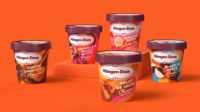The Ice Men Cometh
The Ice Men Cometh
By Dana Dratch
Two brands of “premium” spring water ice cubes are combining convenience and purity claims to appeal to the discerning consumer.
Two North American companies are out to change the way U.S. consumers look at the ice in their drinks.
This fall, both aquaICE and Water Bank of America are planning to introduce pre-filled trays of premium water that consumers can buy, store on the shelf, and freeze as needed. The twist: cubes are individually sealed with a layer of film in plastic trays, so that users can take one or many without worrying about the remaining ice absorbing freezer flavors.
Ohio-based aquaICE plans to start distributing nationwide within the next few months, says George Varney, the company’s chief operating officer. The product features one-ounce cubes of purified water packaged in five, 10-cube trays and will retail for about $4.99, he says.
AquaICE has been available in Ohio since July of 2005. When it rolls out to a larger market this fall, the company will also introduce two new options: flavored cubes infused with either lemon or lime essence.
Ice Rocks Secured Spring Water Ice Cube, produced by Toronto-based Water Bank of America Inc., plans to debut in a host of major U.S. markets on October 1, using French spring water for its .53-ounce cubes, says Jean-Jean Pelletier, Water Bank’s co-founder. Later next year, the company will add a Canadian spring as a water source. Four trays with a dozen cubes each will retail for about $3.99, he says.
The target market for both products? The bottled water crowd. Both brands reasoned that consumers who don’t drink tap water would likely prefer an alternative for their ice, as well.
It’s for “people who are used to good water” who enjoy “knowing that they are getting purified ice cubes,” says Varney, whose product is marketed on the bottled water aisle.
After several years of research and test marketing, aquaICE believes that the average buyers will be “anywhere from 18 to the mid-50s, and probably more women than men initially,” Varney says.
Both brands are aiming for higher-end retail outlets, grocery stores and hotels. And both emphasize the taste difference between their products and tap water ice.
To buy a $60 bottle of scotch and pour it over tap water ice cubes? “It’s ridiculous,” Pelletier says.
Ice ice, baby
Ice is a hot commodity. The packaged ice industry generates between $2 billion and $2.5 billion annually, according to Jane McEwen, executive director of the International Packaged Ice Association, an industry trade group. And while all packaged ice meets food-grade standards, the association estimates that 80 percent is used for cooling purposes, while just 20 percent is actually consumed in foods and beverages, she says.
The idea of using spring water or purified water and marketing consumable ice for home use has been around a while, but it’s gaining ground, says McEwen.
“Consumers are becoming more aware—look at bottled water in the last 10 years. It’s now starting to spill over into ice,” she says.
But until now, those ice products were primarily regional. Typically, ice made from purified water and marketed strictly for consumption by the home user is packaged in bags weighing from three to 10 pounds. Depending on the brand, the bag might reseal with a simple twist tie, plastic tie or, in some more premium brands, a reclosable zipper. Generally, cost tends to be less than $3.
What’s different, though, with both aquaICE and Ice Rocks is that they are marketed unfrozen, in pre-packaged plastic trays, and in much smaller quantities.
Packaged to please
Both aquaICE and Ice Rocks have put a lot of thought into packaging.
Varney admits that his company went through 12 to 15 different package designs in the past year before selecting the one consumers will see when the brand expands its market this fall.
The most important element? Since the product is new, consumers need to be able to see it to understand exactly what it is they are buying, says Varney. AquaICE’s solution: a cellophane window on the front of the box that gives the buyer a bird’s eye view of the trays and cubes within.
“The cube is the selling point,” says Michael Zarrillo, founder of Artemis Creative Inc., the Atlanta-based firm that designed the aquaICE packaging.
The company also enlarged the size of the cubes from .63 ounces to a full ounce. That decision came after much consumer testing, says Varney. “People wanted a larger cube,” he says. “I think part of it is the value—if you’re going to be paying for this, you want value.”
The blue packaging is accented with either yellow or green on the lemon and lime flavors. In addition, a chart on the back will demonstrate how a different number of lemon or lime cubes (from one to four), will add anything from a just hint of flavor to that equivalent to a wedge of fruit.
The company also discovered that five-tray packs went over better with consumers than those with 10. “It’s easier to handle,” says Zarrillo, who says the team wanted to make the product especially easy and convenient for female buyers.
Ice Rocks is also out to appeal to women, who do most of the food buying, says Pelletier. Designed by Miami Beach-based design firm ESBG Design, the brand’s box is a soft blue with cream and navy accents, purposely reminiscent of the color palettes used in fine cosmetic or perfume packaging. The touches of navy blue also invoke elegance and class, he says.
But taste is the big selling point. And, for that reason, both product makers are relying on a marketing strategy that involves a lot of customer sampling.
Says Varney, “This is something that you want to get into the customer’s hands.”
Dana Dratch is an award-winning freelance writer based in Atlanta.
Where to go for more information...
• Ice industry stats. At the International Packaged Ice Association, call 813.258.1690 or visit www.packagedice.org.
• Package design. At Artemis Creative, call 404.874.7487 or visit www.artemiscreative.com.
• Brand packaging. At ESBG Design, call 617.625.0533 or visit www.esbgdesign.com.
Looking for a reprint of this article?
From high-res PDFs to custom plaques, order your copy today!








